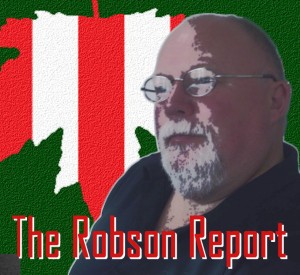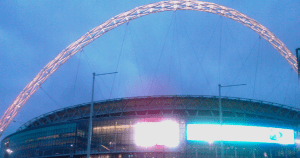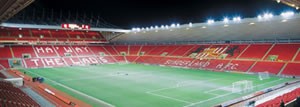
John McCormick writes: in 1956 John Christopher wrote a post-apocalyptic novel called The Death of Grass. It featured a virus that killed all grass-type plants (monocotyledons, in the trade) and thus wiped out many of the planet’s food sources. If I remember correctly, the hero and heroine ended up pushing a pram from London to the Lake District, where someone they knew was growing cabbages in a hidden valley.
Jeremy Robson takes this a little bit further and gives us another doomsday scenario, one that some of you may think is even scarier:

How would you feel if Sunderland AFC decided to introduce an artificial pitch?
The Professional Footballer’s Association (PFA), have reacted angrily to the plans to introduce artificial surfaces in Leagues 1 & 2. Artificial pitches can be introduced as early as next year. 3G surfaces are a huge progression from the terrible surfaces that were introduced at Preston, Oldham, Luton and QPR back in the 80s. I only ever saw a couple of games in the flesh on those old Astroturf pitches, and there was an unquestionable advantage to the home sides at that time. In one of those games at Oldham’s Boundary Park, the ball wouldn’t even stay in place for corners and goal kicks, resulting in someone with a bucket of sand entering the fray as and when he was needed to put down a mini sand dune so play could resume.
These pitches didn’t stay for long and they have been banned from English professional football since 1995. However, the progress in terms of the quality and integrity of artificial surfaces has improved markedly since then. Today’s surfaces bear little resemblance to their predecessors. The PFA claim that they are concerned with the long term health and safety of players, after playing on artificial surfaces, and are understandably aggrieved that they have not been consulted, and the old arguments about unfair advantage to home sides has resurfaced.
In Scotland, artificial pitches are being used, apparently with great success. Queen of the South, Hamilton Academical, Annan Athletic, Airdrie, Montrose, Stenhousemuir, Falkirk, Forfar, Clyde, East Stirling, and Alloa Athletic have all gone down this route.
Why has grass reached a point of becoming almost obsolete?
Articial surfaces can be used all day, as they don’t require recovery time. They can be used for other sports such as rugby and hockey. Youth teams can train and play games on the same surfaces as the first XI, thus reducing the costs associated with owning several field for Academy teams etc. There’s also the advantage of having a standard surface throughout the year, avoiding the lottery of football in mud bath conditions which were so common in the 60s and 70s. North of the border, Sport Scotland has contributed to the cost of installation which can be up to half a million. Professional clubs are looking more to their local communities for involvement and support, much more so than their English counterparts.
Having witnessed football being played on artificial surfaces first hand in Canada over the last few years, I must admit that any prejudices born out of what we witnessed back in the 80s with the early plastic pitches, have long since disappeared. It has to be said though, that the feel of these pitches does seem to vary considerably. There is no way of knowing which generation of the technology you are walking on, and some of the now aging pitches feel very spongy beneath the feet. There was a field my son played on last week that felt this way and in all honesty it was not a surface I would have liked to play on as a youngster. That said, in almost all cases, once a game begins, you soon forget that these modern surfaces are not grass at all.

One of the major concerns for clubs in Leagues 1 & 2 must be any issue raised by gaining promotion to the Championship and beyond when there is currently no ratification for artificial surfaces in the top two divisions. This was a specific concern of the Rochdale chairman who recently said that his club had no intention of going down that route. Given the comparatively lofty position of his club at the moment, that may have presented a real problem as early as April next year if they gain promotion.
While the concerns of the PFA may be legitimate, and the welfare of their members its paramount concern, the majority of the players of today are exposed to the use of artificial surfaces and a great many of the Academies in the top leagues across Europe rarely train or play on grass these days. Perhaps it’s time to discard prejudice and move on.
Can’t see anything wrong with this. Better standard of pitch, all in all. What are your objections?
It’s because the grass roots don’t recover if too much football is played on natural surfaces.
What I don’t get is that Greg Dyke says we need more 3G pitches to develop the grass roots!
That’s a bit strong Bill. Say more?
artificial grass = artificial football
It just melts Eric.
Following on from John’s comment re the death of grass. Back in the early 70s, Terry Venables wrote a football novel called “They used to play on grass.” This would have been around 1971/2, if I recall correctly.
Ironically he was the QPR manager when they installed the first artificial surface at Loftus Road.
Grass for me every time. That astroturf is a bugger to roll into a decent spliff and almost impossible to light.
I don’t want to watch football played on an artificial surface.
I would stop going, not renew my seat, which I’m thinking of doing anyway because of silly kick-off times, which can be almost anytime over the weekend, international breaks which mean we go weeks without seeing a home game, and not even being able to park within reasonable distance of the ground because of new restrictions.
Add to that the fact that we know we’re not going to win anything before a ball is kicked (yes, I was at Wembley earlier in the year) as now it’s simply which owners have the most money that determines the winner.
They want a break in the middle of the season because it’s a bit cold, an extra game to be played abroad somehow and a World Cup in Qatar which will take the PL season into the middle of the summer – a time when I’d rather play golf, watch cricket, enjoy the great outdoors and go on holiday.
Actually, the more I think about it, maybe artificial pitches may not be such a bad idea after all …